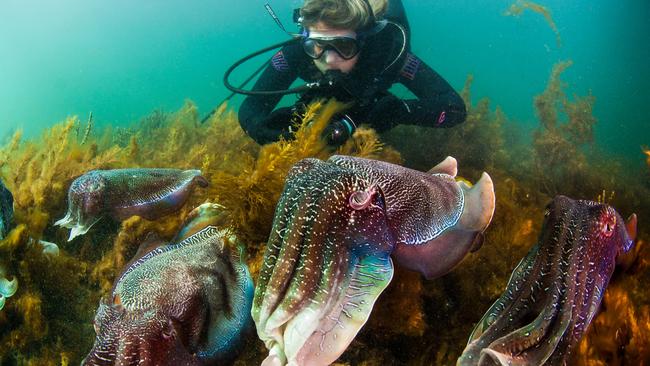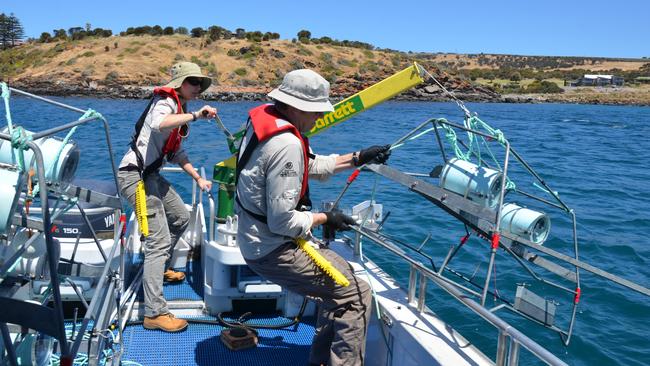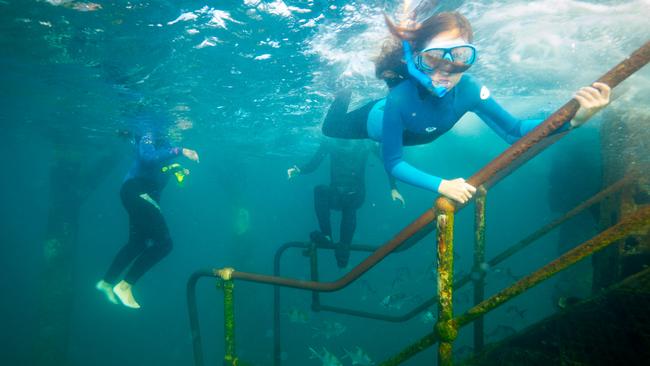South Australian marine parks: Five-year status report shows large fish numbers, no economic impact
SOUTH Australia’s marine parks began operating in 2012. We look at what difference the parks have made to sea life in that time.

SA News
Don't miss out on the headlines from SA News. Followed categories will be added to My News.
WHAT’S A MARINE PARK?
South Australia has 19 declared marine parks divided into zones where different activities are permitted.
This is to ensure the protection of marine life, about 85 per cent of which is not found anywhere else in the world.
WHAT’S THE REPORT ABOUT?
The Environment Department’s marine parks five-year status report 2012-17 assesses the progress of ecological and socio-economic outcomes that will inform “ongoing adaptive management”.

WHAT’S IN THE PARKS?
An estimated 152,000 fish of 205 species have been counted across the marine parks, with offshore island sanctuary zones found to have the highest abundance of large fish.
Large fish, which can produce more young, and maintain “ecosystem balance and function”, are also an indicator of a marine park’s effectiveness because they are often targeted by commercial and recreational fishers.
The largest shark measured was a 3.1m white shark, while a 1.2m eagle ray and a 1.1m yellowtail kingfish have also been recorded.
Fish comprise 54 per cent of marine park animals. Molluscs, including octopuses, slugs and mussels, make up 21 per cent of the species, while echinoderms such as sea urchins represent 16 per cent.
In the Encounter Marine Park between Cape Jervis and Penneshaw, the Sponge Gardens sanctuary zone boasts an abundance of iconic fish species. Almost 40 blue devils have been recorded in the deep water trenches, 15 harlequin fish and more than 100 western blue gropers, all of which can live for 40 and 70 years.

WHAT IMPACTS ARE PARKS HAVING?
In the Cape du Couedic sanctuary zone off Kangaroo Island, a study of rock lobsters last year found that since fishing was last permitted in 2013-14, there has been a 42 per cent rise in numbers and an 81 per cent rise in overall weight of lobster stocks.
Environment Minister Ian Hunter said: “Marine parks are expected to take many years to make a difference, yet we are already seeing that our sanctuary zones are successfully protecting marine life.”
The report does not comprehensively evaluate the effectiveness of the management plans or zoning arrangements. That will have to wait for the 10-year report in 2021.
The Wilderness Society says the scientific evidence on the benefits of sanctuaries may justify park expansions.

IS THERE ECONOMIC IMPACT?
The report says there is “no evidence of negative regional impact that correlates with the implementation of marine park management plans”. It also states that industries such as aquaculture and shipping have continued to operate unaffected, commercial fisheries are stable, and that there is no evidence from fish prices that local consumers are paying more for locally-caught fish.
Four new tourism operators have begun using marine parks, and shark cage diving is estimated to contribute $12.8 million annually to SA’s economy and has created 80 jobs.

HOW ARE PARK RULES ENFORCED?
Patrols have increased almost threefold since 2014-15 to 4565 in 2016-17. They are done from the shore, by boat and plane.
The Zanoni shipwreck within the boundaries of the Offshore Ardrossan sanctuary zone is an attractive site for divers who can enter the exclusion zone with a permit.
Patrols have resulted in 30 prosecutions for offences such as anchoring too close or not having the necessary permits.



